Test Methodology for Short-Circuit Assessment and Safe Operation Identification for Power SiC MOSFETs
Abstract
:1. Introduction
2. Short-Circuit Assessment Methodology
2.1. Power Test Bench
2.2. Test Assessment Protocol
- STEP 0: Identification of the main applied stressors (e.g., , , ) and environmental parameters: the role of the main electrical stressors and environmental parameters (e.g., case temperature) should be analyzed and taken into account.
- STEP 1: Determine the Short-Circuit Withstand Time () on samples with different threshold voltages (). This procedure should be carried out for different drain–source voltages (). For this purpose, , , and of the device voltage rating are typically selected.
- STEP 2: Determine the Maximum SC Number of Pulses () according to a given fraction (—see here after) of the without reaching a failure. Noteworthy is that DC and AC characterization (tracking parameters—TP) of the device before/after SC tests are performed. In addition, in situ readouts must be conducted (for instance, , , and ). Here, = , , and have been chosen, while the main TPs are SC energy (), maximum SC drain–source current , , and .
- STEP 3: Aging protocol for tracking the performances of the DUT over time. The evolution of TPs is monitored by means of arbitrarily chosen acceptance intervals (compliance mask). However, a refinement must be considered (need to track graph evolution). Here, the compliance mask is based on and drops.
- STEP 4: Failure analysis in order to identify device damage, failure modes, and failure mechanisms. Here, failure analysis has been performed on devices with different stress time in order to monitor the degradation evolution.
3. Deployment of the SC Assessment Methodology
3.1. Short-Circuit Test at Low-Medium Voltages (400–600 V)
- Number of Pulses = 400;
- Applied Voltage () = 600 V;
- Gate–source Voltage () = V/18 V;
- ;
- Pulse width () = µs;
- Waiting time = 5 s (between pulses).
3.2. Short-Circuit Test at Higher Voltage (900 V)
3.3. Similarities Between Medium (600 V) and Higher (900 V) SC Operation
4. Application of the SC Assessment Methodology
4.1. Investigation of SC Safe Operating Area
- A: Perform DC characterization before short circuit on available samples.
- B: Short-circuit condition: V, ( s), V; V and . On five groups of DUTs each composed of two DUTs, each group undergoes an increasing number of SC events (100, 200, 300, 400, and 500) as follows: DUT#01 and DUT#06 are submitted to 100 pulses;DUT#02 and DUT#07 are submitted to 200 pulses;DUT#03 and DUT#08 are submitted to 300 pulses;DUT#04 and DUT#09 are submitted to 400 pulses;DUT#05 and DUT#10 are submitted to 500 pulses;
- C: Repeat DC characterization after short circuit on available samples.
- D: Perform the electrical analysis.
4.2. Investigation of Quasi-Simultaneous SC Degradation Study
4.2.1. Quasi-Simultaneous SC Investigation
4.2.2. SC in False Turn-On Operation
4.2.3. Phenomenological and Technological Insight
5. Conclusions
Author Contributions
Funding
Data Availability Statement
Acknowledgments
Conflicts of Interest
References
- Wang, Z.; Shi, X.; Xue, Y.; Tolbert, L.M.; Wang, F.; Blalock, B.J. Design and performance evaluation of overcurrent protection schemes for silicon carbide (SiC) power MOSFETs. IEEE Trans. Ind. Electron. 2014, 61, 5570–5581. [Google Scholar] [CrossRef]
- Nguyen, T.T.; Ahmed, A.; Thang, T.; Park, J.H. Gate oxide reliability issues of SiC MOSFETs under short-circuit operation. IEEE Trans. Power Electron. 2014, 30, 2445–2455. [Google Scholar] [CrossRef]
- Chen, C.; Labrousse, D.; Lefebvre, S.; Petit, M.; Buttay, C.; Morel, H. Study of short-circuit robustness of SiC MOSFETs, analysis of the failure modes and comparison with BJTs. Microelectron. Reliab. 2015, 55, 1708–1713. [Google Scholar] [CrossRef]
- Zhou, X.; Su, H.; Wang, Y.; Yue, R.; Dai, G.; Li, J. Investigations on the degradation of 1.2-kV 4H-SiC MOSFETs under repetitive short-circuit tests. IEEE Trans. Electron Devices 2016, 63, 4346–4351. [Google Scholar] [CrossRef]
- Reigosa, P.D.; Iannuzzo, F.; Luo, H.; Blaabjerg, F. A short-circuit safe operation area identification criterion for SiC MOSFET power modules. IEEE Trans. Ind. Appl. 2016, 53, 2880–2887. [Google Scholar] [CrossRef]
- Benmansour, A.; Azzopardi, S.; Martin, J.C.; Woirgard, E. Trench IGBT failure mechanisms evolution with temperature and gate resistance under various short-circuit conditions. Microelectron. Reliab. 2007, 47, 1730–1734. [Google Scholar] [CrossRef]
- Reigosa, P.D.; Iannuzzo, F.; Ceccarelli, L. Effect of short-circuit stress on the degradation of the SiO2 dielectric in SiC power MOSFETs. Microelectron. Reliab. 2018, 88, 577–583. [Google Scholar] [CrossRef]
- Shoji, T.; Kuwahara, M.; Usui, M. Dependence of short-circuit withstand capability of SiC MOSFETs on short-circuit failure time. IEEE Trans. Power Electron. 2021, 36, 11739–11747. [Google Scholar] [CrossRef]
- Boige, F.; Richardeau, F. Gate leakage-current analysis and modelling of planar and trench power SiC MOSFET devices in extreme short-circuit operation. Microelectron. Reliab. 2017, 76, 532–538. [Google Scholar] [CrossRef]
- JESD22-A108G; Temperature, Bias, and Operating Life (HTOL) Test Method for Semiconductor Devices. JEDEC Standard. JEDEC Solid State Technology Association: Arlington, VA, USA, 2022.
- Boige, F. Caractérisation et Modélisation électrothermique Compacte étendue du MOSFET SiC en Régime extrême de Fonctionnement Incluant ses Modes de Défaillance: Application à la Conception d’une Protection Intégrée au plus Proche du Circuit de Commande. Ph.D. Thesis, Institut National Polytechnique de Toulouse, Toulouse, France, 2019. [Google Scholar]
- Barazi, Y.; Richardeau, F.; Jouha, W.; Reynes, J.M. VDS and VGS depolarization effect on SiC MOSFET short-circuit withstand capability considering partial safe failure-mode. Energies 2021, 14, 7960. [Google Scholar] [CrossRef]
- Romano, G.; Fayyaz, A.; Riccio, M.; Maresca, L.; Breglio, G.; Castellazzi, A.; Irace, A. A comprehensive study of short-circuit ruggedness of silicon carbide power MOSFETs. IEEE J. Emerg. Sel. Top. Power Electron. 2016, 4, 978–987. [Google Scholar] [CrossRef]
- Othman, D.; Lefebvre, S.; Berkani, M.; Khatir, Z.; Ibrahim, A.; Bouzourene, A. Robustness of 1.2 kV SiC MOSFET devices. Microelectron. Reliab. 2013, 53, 1735–1738. [Google Scholar] [CrossRef]
- Unger, C.; Pfost, M. Particularities of the short-circuit operation and failure modes of SiC-MOSFETs. IEEE J. Emerg. Sel. Top. Power Electron. 2021, 9, 6432–6440. [Google Scholar] [CrossRef]
- Oliveira, J.; Frey, P.; Morel, H.; Reynes, J.; Burky, J.; Coccetti, F.; Iannuzzo, F.; Piton, M. Failure degradation similarities on power SiC MOSFET devices submitted to short-circuit stress and accelerated switching conditions. Microelectron. Reliab. 2023, 148, 115166. [Google Scholar] [CrossRef]
- Richardeau, F.; Boige, F. Circuit-type modelling of SiC power Mosfet in short-circuit operation including selective fail-to-open and fail-to-short modes competition. Microelectron. Reliab. 2019, 100, 113501. [Google Scholar] [CrossRef]
- Jahdi, S.; Alatise, O.; Gonzalez, J.O.; Ran, L.; Mawby, P. Comparative analysis of false turn-on in silicon bipolar and SiC unipolar power devices. In Proceedings of the 2015 IEEE Energy Conversion Congress and Exposition (ECCE), Montreal, QC, Canada, 20–24 September 2015; pp. 2239–2246. [Google Scholar]
- Sanchez, J.; Gharbi, M.; Tranduc, H.; Rossel, P. Quasisaturation effect in high-voltage VDMOS transistors. IEE Proc. I (Solid-State Electron. Devices) 1985, 132, 42–46. [Google Scholar] [CrossRef]
- Pomès, E. Amélioration et suivi de la robustesse et de la qualité de MOSFETs de puissance dédiés à des applications automobiles micro-hybrides. Ph.D. Thesis, INSA, Toulouse, France, 2012. [Google Scholar]

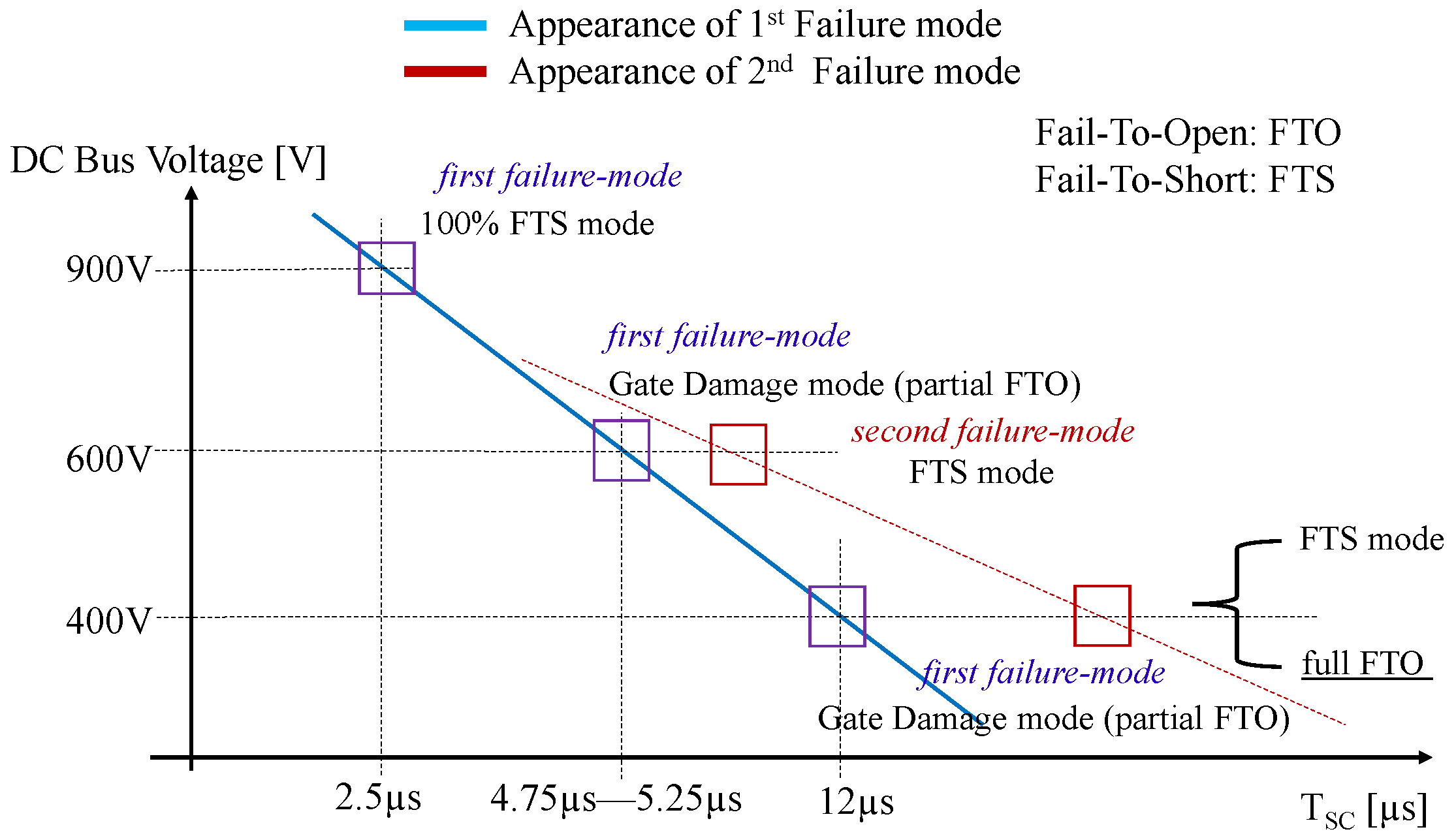




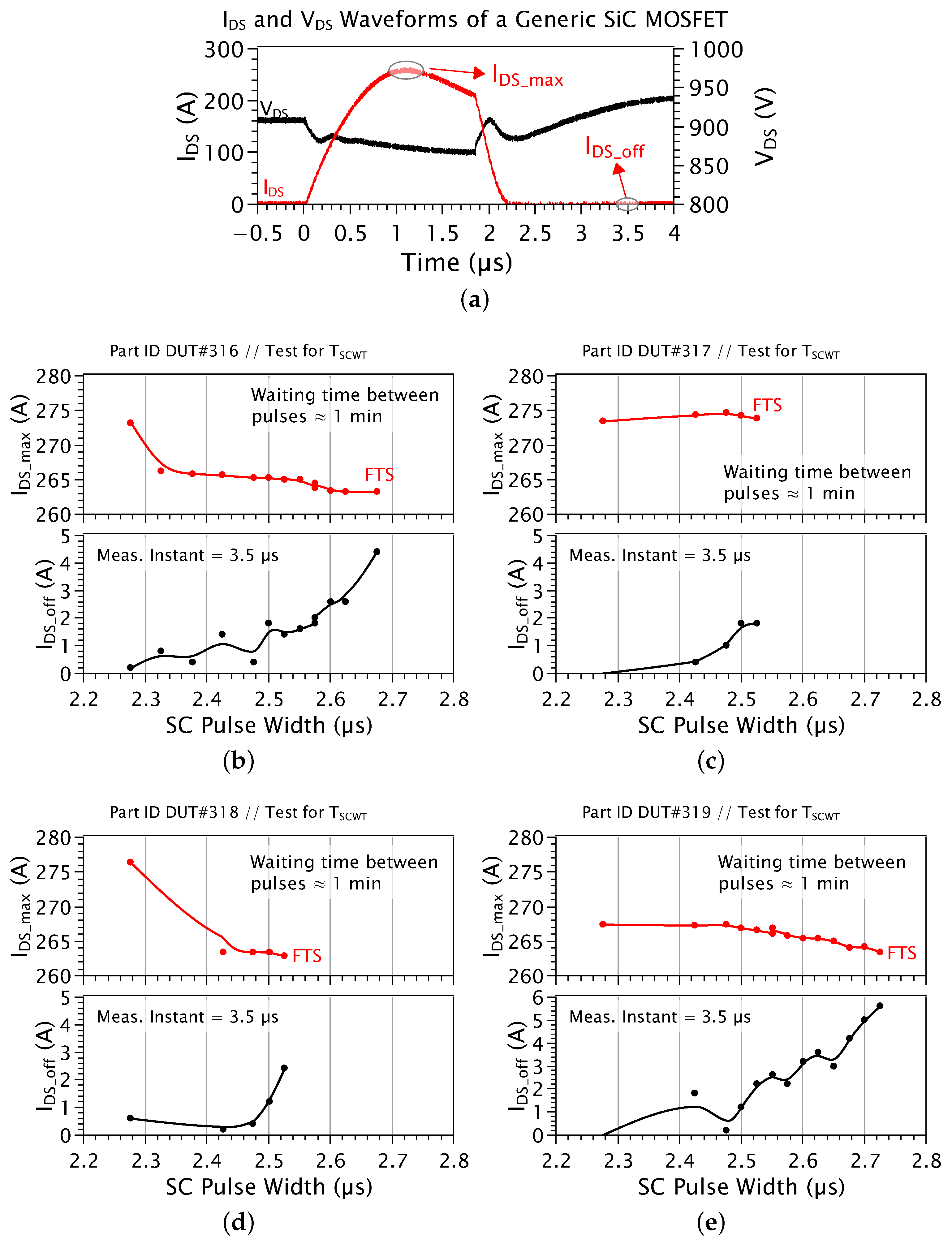

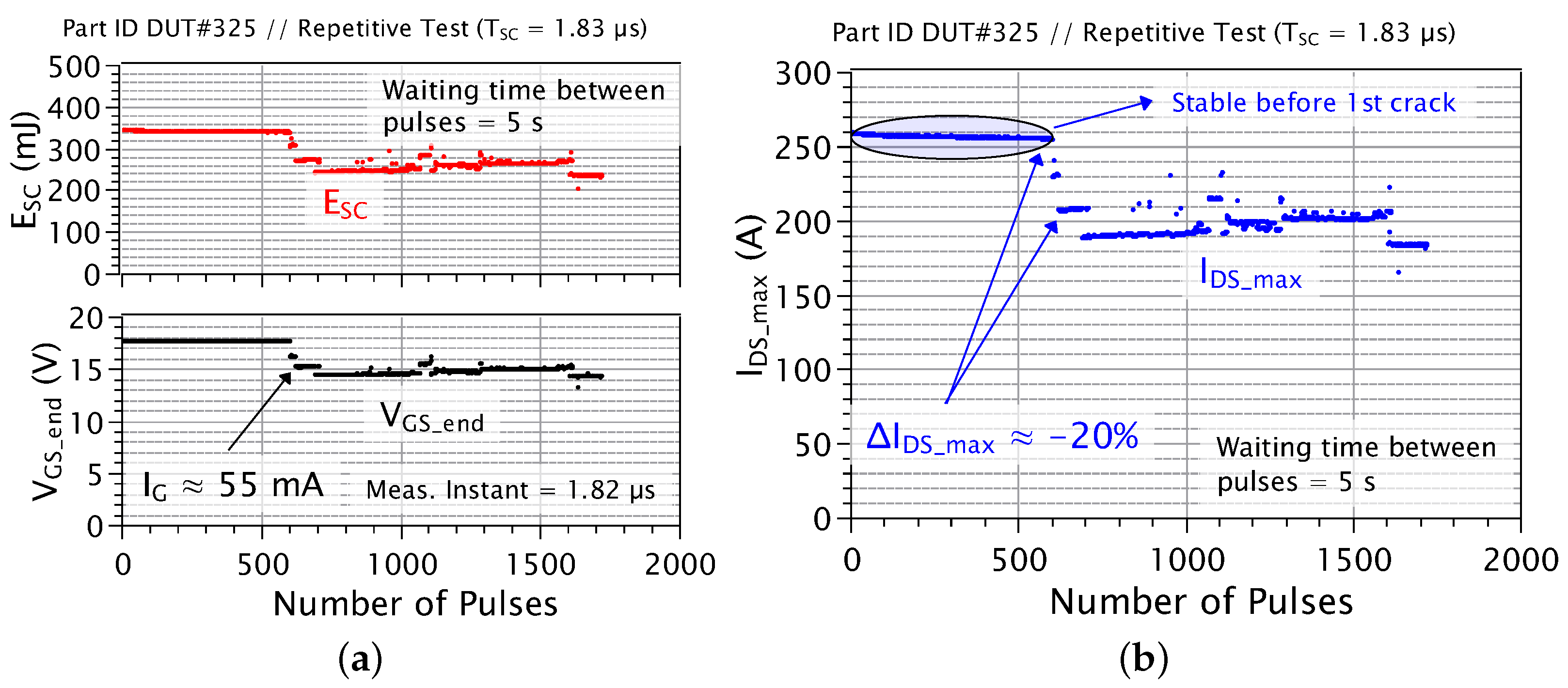
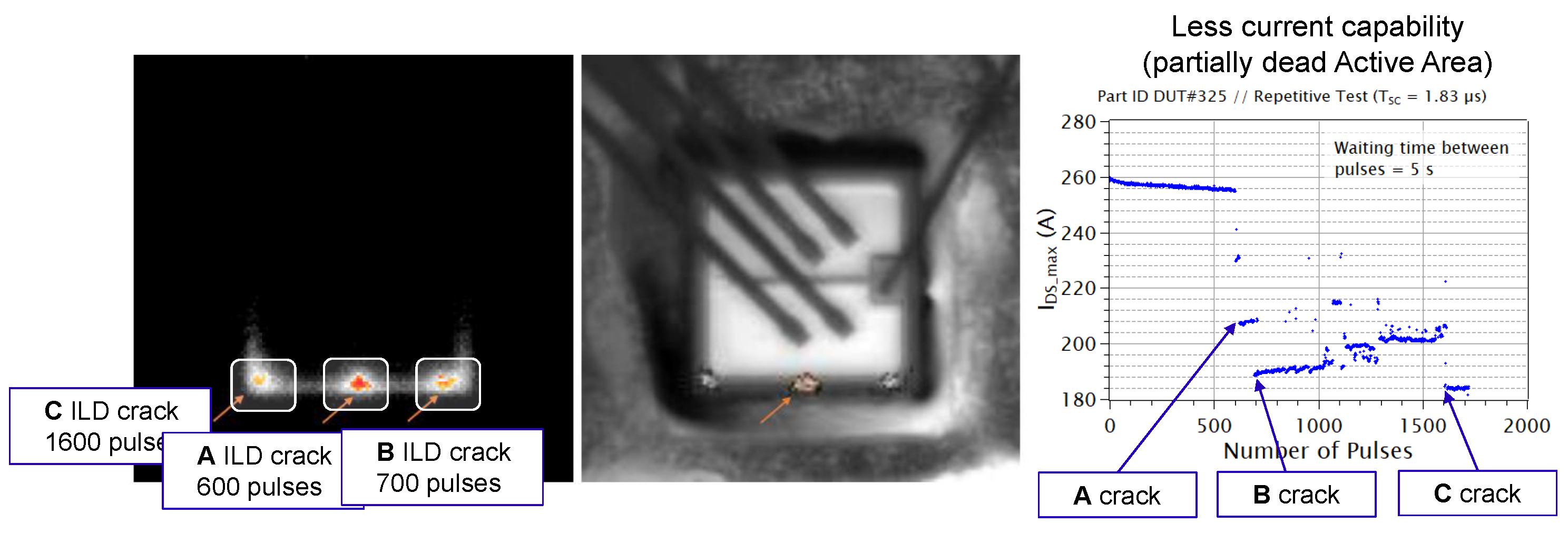
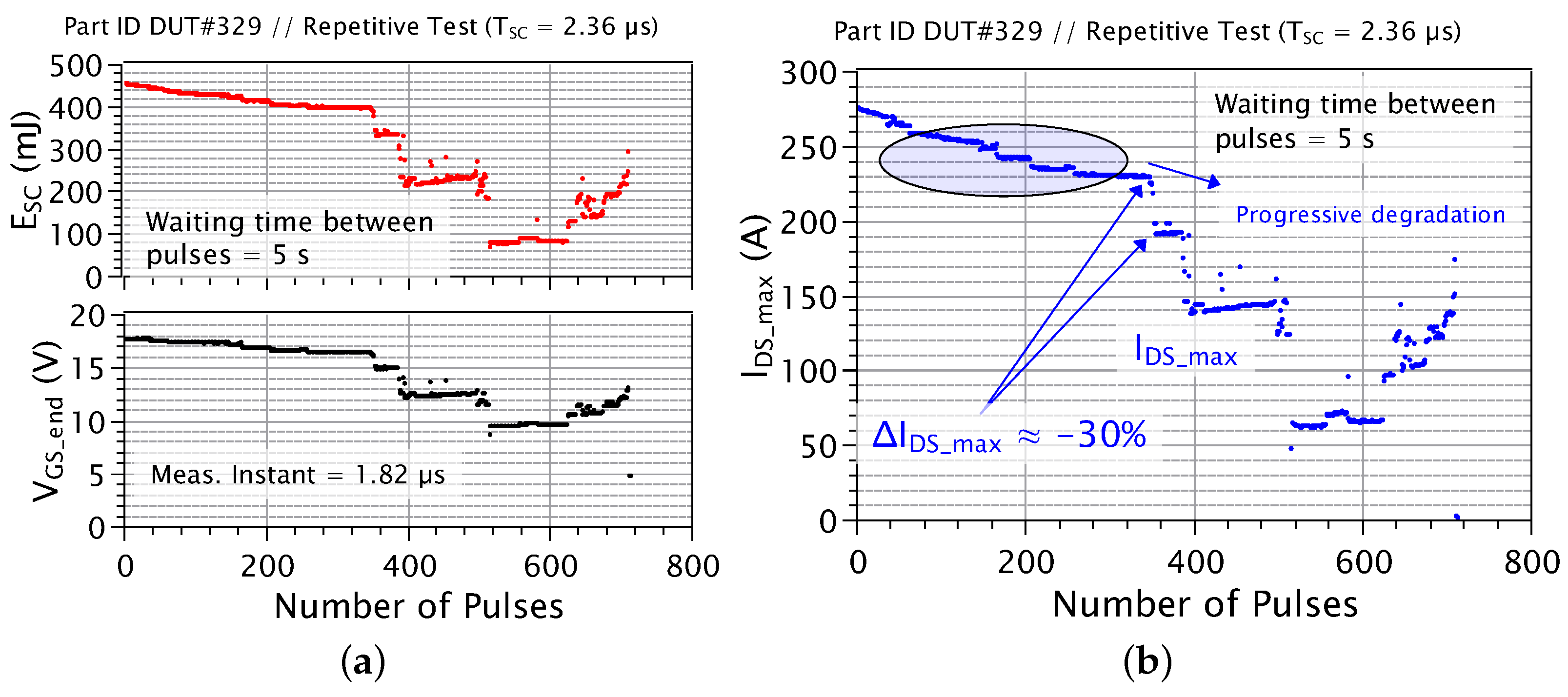

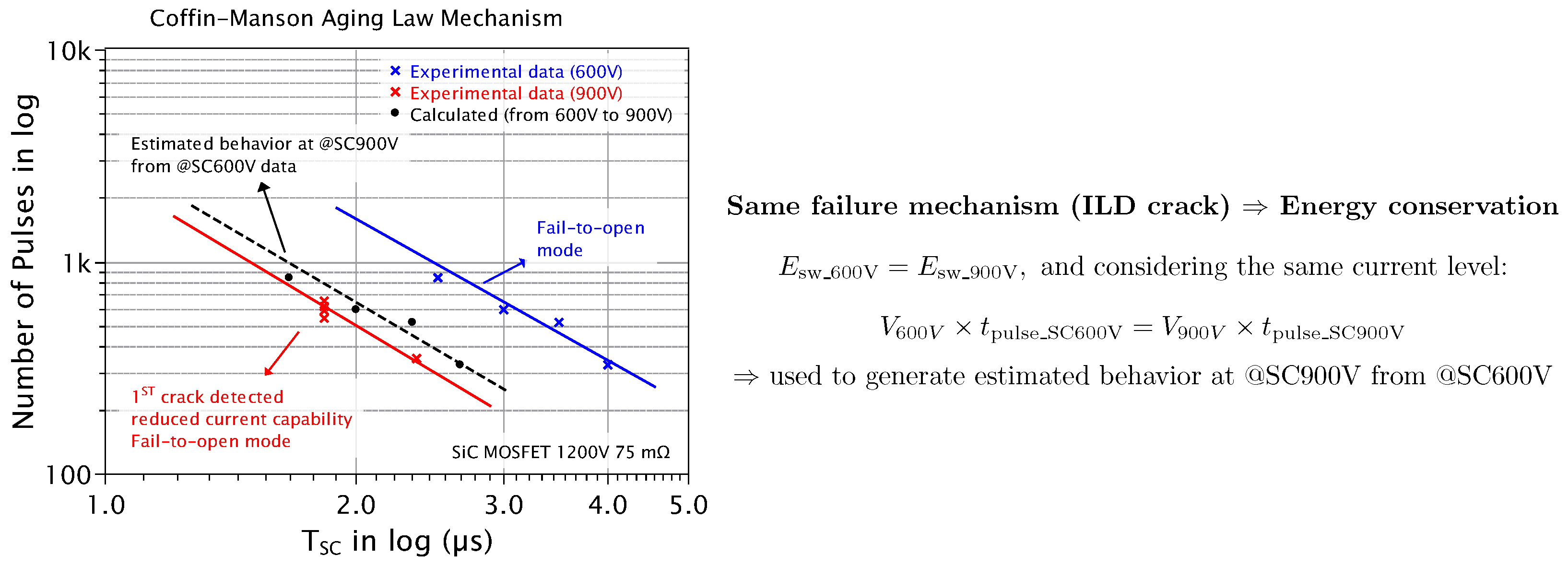

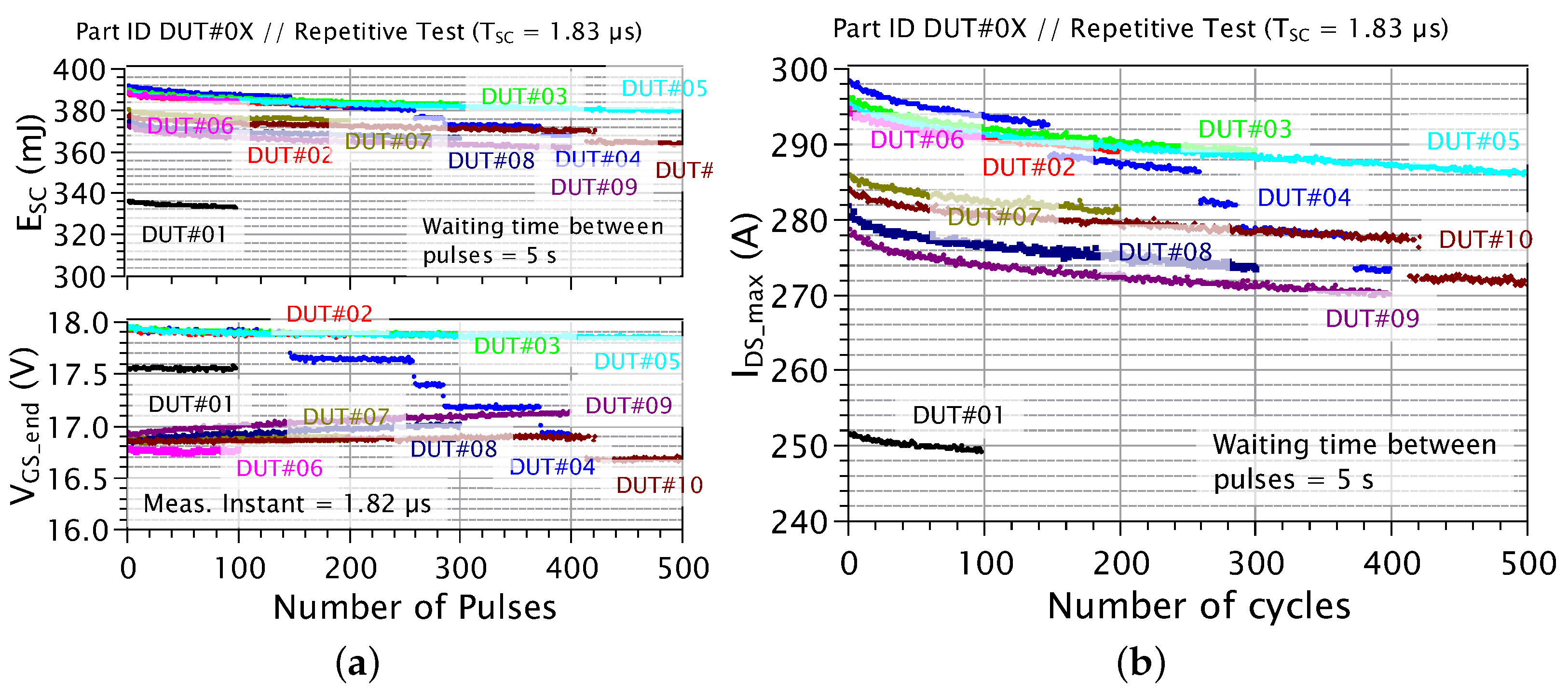



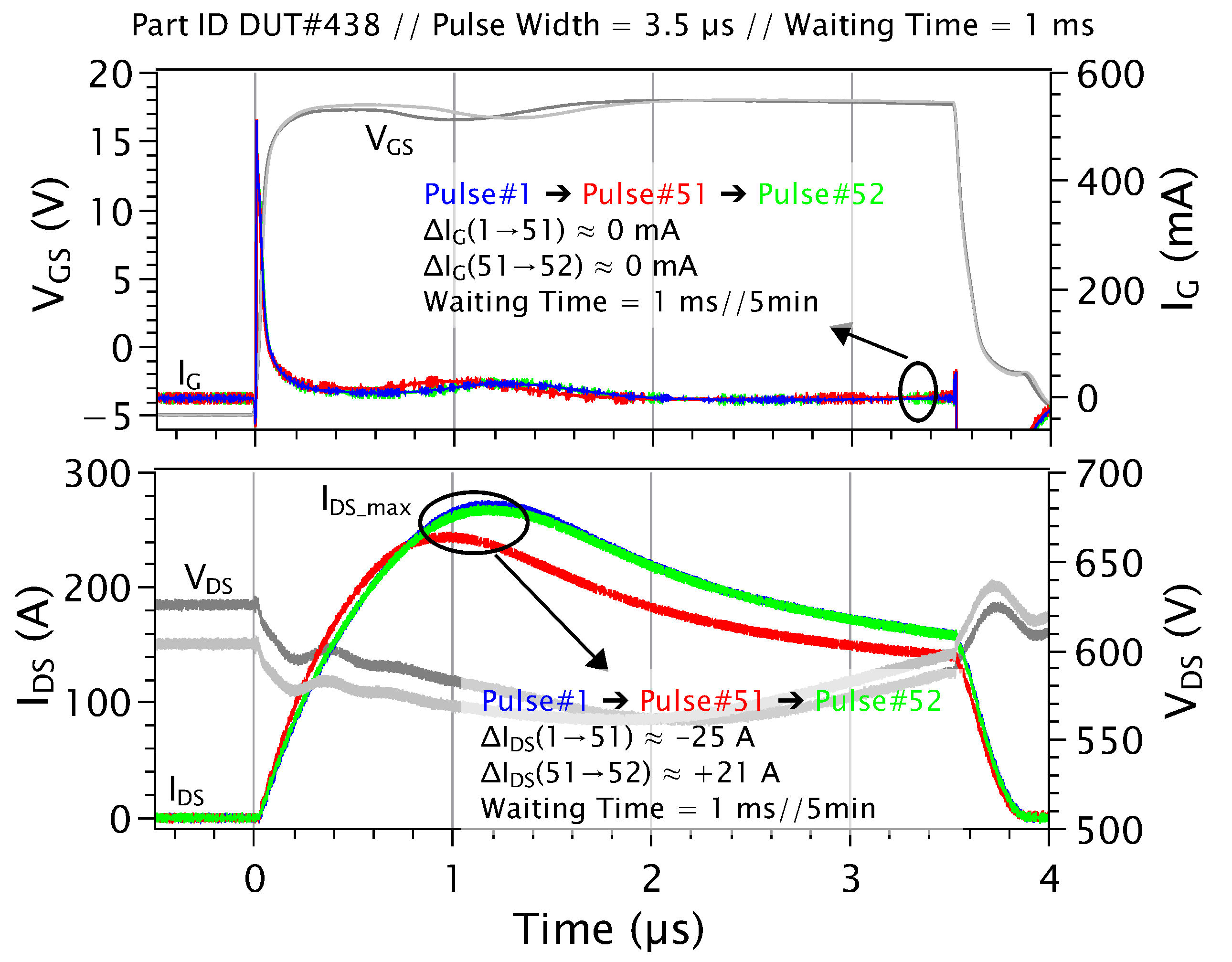




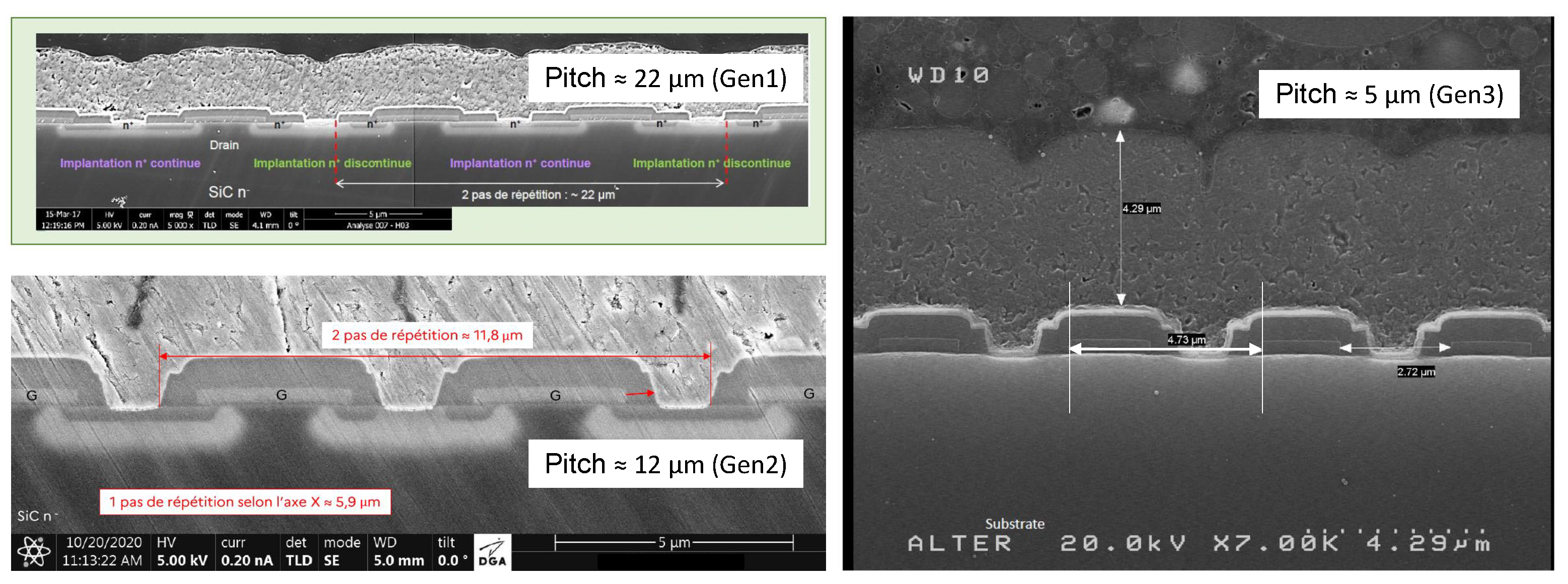
| Device | (A), First Pulse µs | Number of Pulses Before Destruction | Critical (mJ) | (s) |
|---|---|---|---|---|
| DUT#316 | 273.2 | 13 | 478 | 2.7 |
| DUT#317 | 273.4 | 5 | 463 | 2.55 |
| DUT#318 | 276.4 | 5 | 459 | 2.53 |
| DUT#319 | 267.4 | 14 | 486 | 2.7 |
| DUT#320 | 255.8 | 28 | 505.5 | 3.4 |
| Device | SC Pulse Width | After First Crack Detected | SC Energy at Final Pulse (mJ) | Failure Mode |
|---|---|---|---|---|
| DUT#323 | s | Stopped at Pulse#2451 | 244 | — |
| DUT#325 | s | Pulse#621 | 240 | GS partially shorted |
| DUT#329 | s | Pulse#350 | 450 | GS partially shorted |
| Device | Number
of Pulses | Before SC Test | After SC Test | ||||||
|---|---|---|---|---|---|---|---|---|---|
| (V) | (A) | (A) | (V) | (A) | (A) | ||||
| DUT_ref | 3.14 | 78.58 | 1.53 × 10−9 | 3.85 × 10−8 | 3.14 | 79.1 | 6.72 × 10−10 | 3.33 × 10−8 | |
| DUT#1 | 100 | 3.52 | 87.67 | 6.26 × 10−10 | 3.18 × 10−8 | 3.58 | 89.28 | 1.16 × 10−9 | 2.93 × 10−8 |
| DUT#2 | 200 | 3 | 67.56 | 9.86 × 10−10 | 3.56 × 10−8 | 3.27 | 69.98 | 1.08 × 10−9 | 3.09 × 10−8 |
| DUT#3 | 300 | 2.96 | 67.02 | 8.95 × 10−10 | 3.93 × 10−8 | 3.32 | 70.01 | 1.02 × 10−9 | 2.89 × 10−8 |
| DUT#4 | 400 | 2.99 | 66.93 | −1.31 × 10−9 | 3.32 × 10−8 | 3.26 | 84.95 | 4.37 × 10−6 | 2.74 × 10−8 |
| DUT#5 | 500 | 2.97 | 67.1 | 3.14 × 10−10 | 3.85 × 10−8 | 3.42 | 70.63 | 7.44 × 10−10 | 2.99 × 10−8 |
| DUT#6 | 100 | 3.08 | 69.22 | −6.81 × 10−10 | 4.48 × 10−8 | 3.29 | 72.69 | 2.14 × 10−9 | 5.01 × 10−8 |
| DUT#7 | 200 | 2.78 | 72.08 | 1.80 × 10−10 | 3.38 × 10−8 | 3.04 | 74.06 | 2.27 × 10−9 | 3.51 × 10−8 |
| DUT#8 | 300 | 3.55 | 78.72 | 1.18 × 10−9 | 4.04 × 10−8 | 3.96 | 86.5 | 1.56 × 10−9 | 3.66 × 10−8 |
| DUT#9 | 400 | 3.35 | 80.08 | −9.18 × 10−10 | 3.94 × 10−8 | 3.95 | 85.66 | 7.47 × 10−10 | 3.06 × 10−8 |
| DUT#10 | 500 | 2.87 | 73.65 | −8.35 × 10−11 | 3.95 × 10−8 | 3.23 | 75.66 | 4.37 × 10−6 | 2.77 × 10−8 |
Disclaimer/Publisher’s Note: The statements, opinions and data contained in all publications are solely those of the individual author(s) and contributor(s) and not of MDPI and/or the editor(s). MDPI and/or the editor(s) disclaim responsibility for any injury to people or property resulting from any ideas, methods, instructions or products referred to in the content. |
© 2024 by the authors. Licensee MDPI, Basel, Switzerland. This article is an open access article distributed under the terms and conditions of the Creative Commons Attribution (CC BY) license (https://creativecommons.org/licenses/by/4.0/).
Share and Cite
Oliveira, J.; Reynes, J.-M.; Morel, H.; Frey, P.; Perrotin, O.; Allirand, L.; Azzopardi, S.; Piton, M.; Coccetti, F. Test Methodology for Short-Circuit Assessment and Safe Operation Identification for Power SiC MOSFETs. Energies 2024, 17, 5476. https://doi.org/10.3390/en17215476
Oliveira J, Reynes J-M, Morel H, Frey P, Perrotin O, Allirand L, Azzopardi S, Piton M, Coccetti F. Test Methodology for Short-Circuit Assessment and Safe Operation Identification for Power SiC MOSFETs. Energies. 2024; 17(21):5476. https://doi.org/10.3390/en17215476
Chicago/Turabian StyleOliveira, Joao, Jean-Michel Reynes, Hervé Morel, Pascal Frey, Olivier Perrotin, Laurence Allirand, Stéphane Azzopardi, Michel Piton, and Fabio Coccetti. 2024. "Test Methodology for Short-Circuit Assessment and Safe Operation Identification for Power SiC MOSFETs" Energies 17, no. 21: 5476. https://doi.org/10.3390/en17215476
APA StyleOliveira, J., Reynes, J.-M., Morel, H., Frey, P., Perrotin, O., Allirand, L., Azzopardi, S., Piton, M., & Coccetti, F. (2024). Test Methodology for Short-Circuit Assessment and Safe Operation Identification for Power SiC MOSFETs. Energies, 17(21), 5476. https://doi.org/10.3390/en17215476






